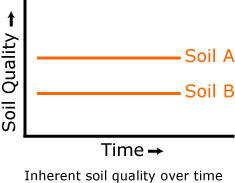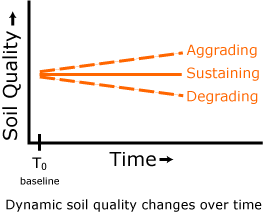The quality of a soil is a combination of inherent and dynamic soil properties. The focus of most soil quality work is dynamic soil properties and how they change in relation to the inherent features of the soil.
Inherent or use-invariant properties change little, if at all, with land use or management practices. They may include soil texture, depth to bedrock, type of clay, CEC, and drainage class. These properties were established as soil formed over millennia. How soils form depends on the five soil-

forming factors identified by Hans Jenny (1941) and others:
- climate (precipitation and temperature)
- topography (shape of the land)
- biota (native vegetation, animals, and microbes)
- parent material (geologic and organic precursors to the soil)
- time (time that parent material is subject to soil formation processes)
Dynamic properties or use-dependent properties can change over the course of months and years in response to land use or management practice changes. Dynamic properties include organic matter, soil structure, infiltration rate, bulk density, and water and nutrient holding capacity. Changes in dynamic properties depend both on land management practices and the inherent properties of the soil. For example, the organic matter levels in soil depend on tillage practices and the types of plants growing (management), but the total amount of organic matter is constrained by soil texture and climate (inherent features). Some properties, such as bulk density, may be considered inherent properties below 20-50 cm, but are dynamic properties near the surface.

Jenny, H. 1941. Factors of Soil Formation: A System of Quantitative Pedolog. Dover Pub., Mineola, N.Y.


No comments:
Post a Comment